A 5.43 nV/√Hz Chopper Operational Amplifier Using Lateral PNP Input Stage with BJT Current Mirror Base Current Cancellation
Abstract
:1. Introduction
2. Circuit Implementation
3. Measurement Results
4. Discussion
5. Conclusions
Author Contributions
Funding
Acknowledgments
Conflicts of Interest
References
- Microchip MCP6V91. Available online: http://ww1.microchip.com/downloads/en/DeviceDoc/20005434B.pdf (accessed on 18 October 2020).
- Analog Devices ADA4522. Available online: https://www.analog.com/media/en/technical-documentation/data-sheets/ADA4522-1_4522-2_4522-4.pdf (accessed on 18 October 2020).
- Texas Instruments OPA388. Available online: https://www.ti.com/lit/ds/symlink/opa388.pdf?ts=1602963493359&ref_url=https%253A%252F%252Fwww.google.com%252F (accessed on 18 October 2020).
- STMicroelectronics TSZ181. Available online: https://www.st.com/resource/en/datasheet/tsz181.pdf (accessed on 18 October 2020).
- On Semiconductor AND9857. Available online: https://www.onsemi.com/pub/Collateral/AND9857-D.PDF (accessed on 18 October 2020).
- Enz, C.C.; Temes, G.C. Circuit techniques for reducing the effects of op-amp imperfections: Autozeroing, correlated double sampling, and chopper stabilization. Proc. IEEE 1996, 84, 1584–1614. [Google Scholar] [CrossRef] [Green Version]
- Opris, I.E.; Kovacs, G.T.A. A rail-to-rail ping-pong op-amp. IEEE J. Solid-State Circuits 1996, 31, 1320–1324. [Google Scholar] [CrossRef]
- Oliaei, O. Noise analysis of correlated double sampling SC integrators with a hold capacitor. IEEE Trans. Circuits Syst. I Fundam. Theory Appl. 2003, 50, 1198–1202. [Google Scholar] [CrossRef]
- Bakker, A.; Thiele, K.; Huijsing, J.H. A CMOS nested-chopper instrumentation amplifier with 100-nV offset. IEEE J. Solid-State Circuits 2000, 35, 1877–1883. [Google Scholar] [CrossRef]
- Lee, C.; Song, J. A chopper stabilized current-feedback instrumentation amplifier for EEG acquisition applications. IEEE Access 2019, 7, 11565–11569. [Google Scholar] [CrossRef]
- Burt, R.; Zhang, J. A micropower chopper-stabilized operational amplifier using a SC notch filter with synchronous integration inside the continuous-time signal path. IEEE J. Solid-State Circuits 2006, 41, 2729–2736. [Google Scholar] [CrossRef]
- Witte, J.F.; Makinwa, K.A.A.; Huijsing, J.H. A CMOS chopper offset-stabilized opamp. IEEE J. Solid-State Circuits 2007, 42, 1529–1535. [Google Scholar] [CrossRef]
- Fan, Q.; Huijsing, J.H.; Makinwa, K.A.A. A 21 nV/√Hz chopper-stabilized multi-path current-feedback instrumentation amplifier with 2 μV offset. IEEE J. Solid-State Circuits 2012, 47, 464–475. [Google Scholar] [CrossRef]
- Kim, J.; Kim, H.; Han, K.; You, D.; Heo, H.; Kwon, Y.; Cho, D.D.; Ko, H. Low-noise chopper-stabilized multi-path operational amplifier with nested miller compensation for high-precision sensors. Appl. Sci. 2020, 10, 281. [Google Scholar] [CrossRef] [Green Version]
- Steyaert, M.S.J.; Sansen, W.M.C.; Zhongyuan, C. A micropower low-noise monolithic instrumentation amplifier for medical purposes. IEEE J. Solid-State Circuits 1987, 22, 1163–1168. [Google Scholar] [CrossRef]
- Tsividis, Y.P.; Ulmer, R.W. A CMOS voltage references. IEEE J. Solid-State Circuits 1978, 13, 774–778. [Google Scholar] [CrossRef]
- Degrauwe, M.G.R.; Leuthold, O.N.; Vittoz, E.A.; Oguey, H.J.; Descombes, A. CMOS voltage references using lateral bipolar transistors. IEEE J. Solid-State Circuits 1985, 20, 1151–1157. [Google Scholar] [CrossRef]
- Vittoz, E.A. MOS transistors operated in the lateral bipolar mode and their application in CMOS technology. IEEE J. Solid-State Circuits 1983, 18, 273–279. [Google Scholar] [CrossRef]
- Pan, T.-W.; Abidi, A.A. A 50-dB variable gain amplifier using parasitic bipolar transistors in CMOS. IEEE J. Solid-State Circuits 1989, 24, 951–961. [Google Scholar] [CrossRef]
- Holman, W.T.; Connelly, J.A. A compact low noise operational amplifier for 1.2 µm digital CMOS technology. IEEE J. Solid-State Circuits 1995, 30, 710–714. [Google Scholar] [CrossRef]
- Zhao, D.; Zaman, M.F.; Ayazi, F. A chopper-stabilized lateral-BJT-input interface in 0.6µm CMOS for capacitive accelerometers. In Proceedings of the 2008 IEEE International Solid-State Circuits Conference-Digest of Technical Papers, San Francisco, CA, USA, 3–7 February 2008; pp. 584–585. [Google Scholar] [CrossRef]
- Kusuda, Y. A 5.9 nV/√ Hz chopper operational amplifier with 0.78 μV maximum offset and 28.3 nV/°C offset drift. In Proceedings of the 2011 IEEE International Solid-State Circuits Conference-Digest of Technical Papers, San Francisco, CA, USA, 20–24 February 2011; pp. 242–244. [Google Scholar] [CrossRef]
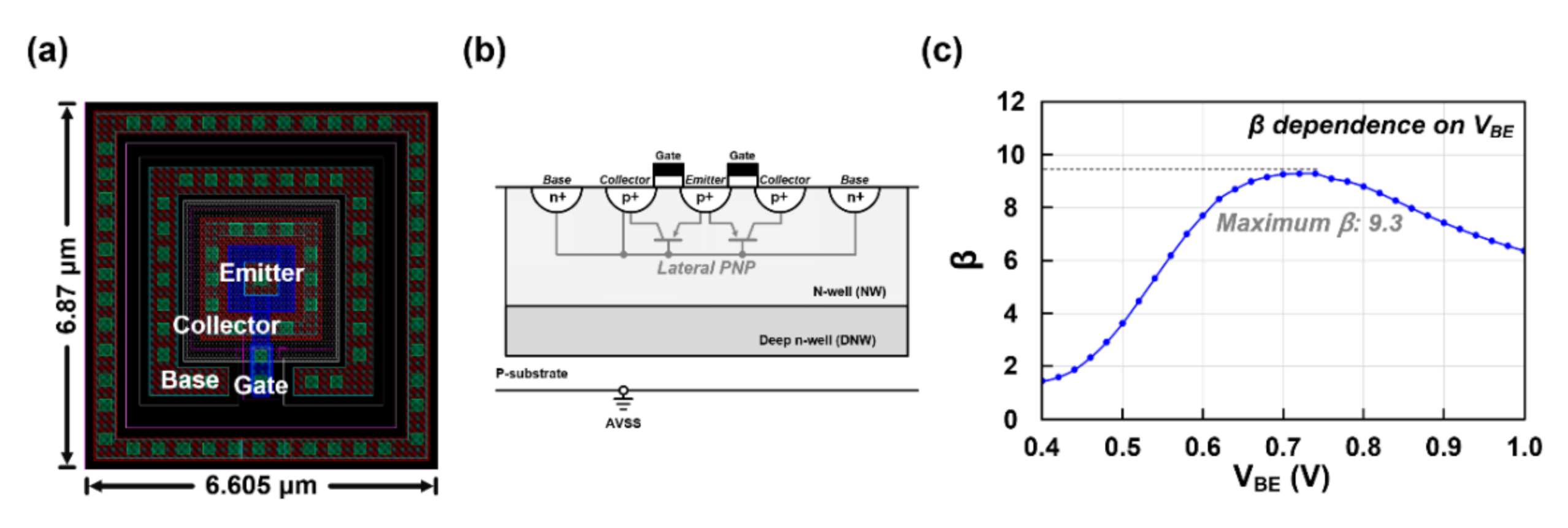
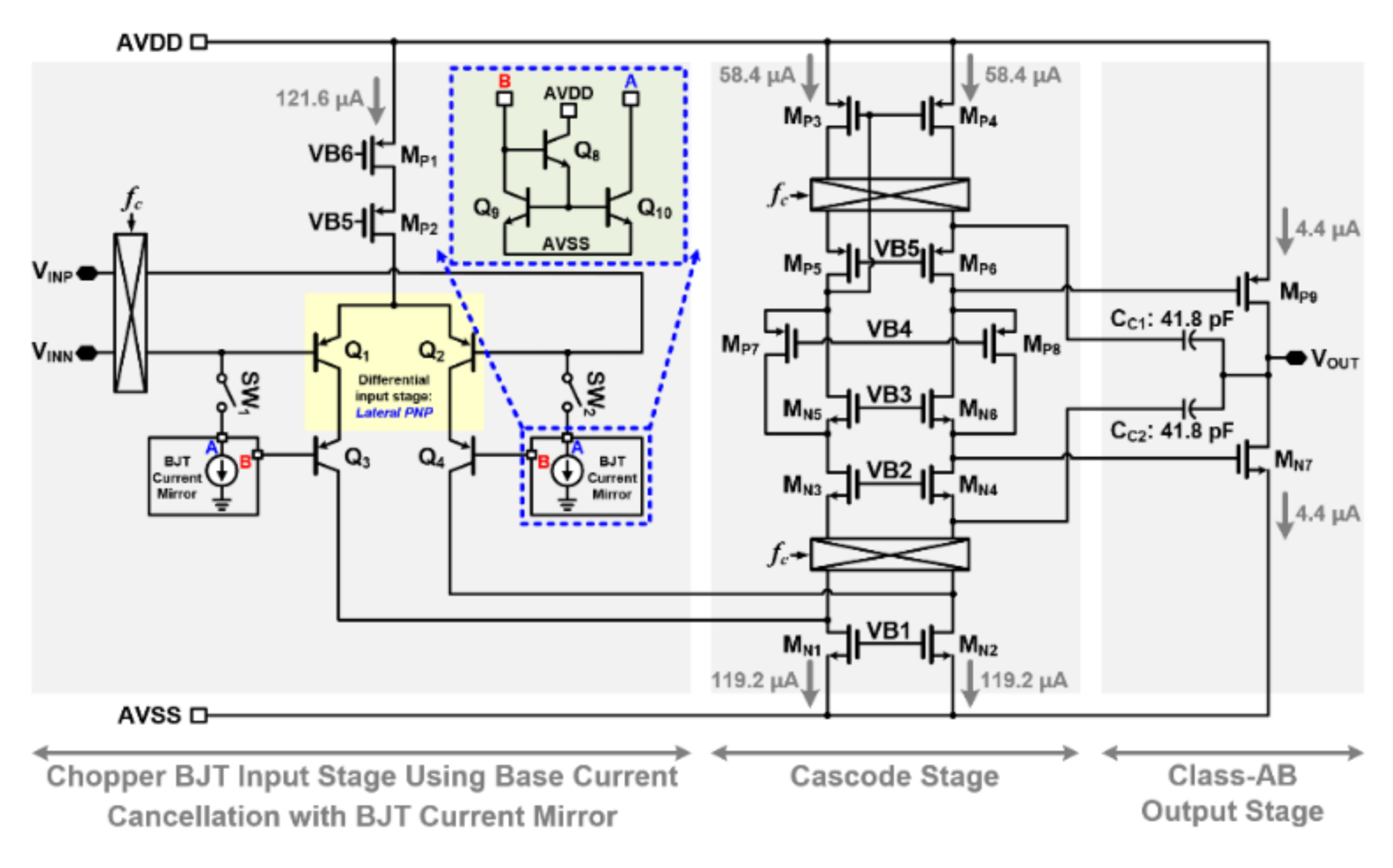
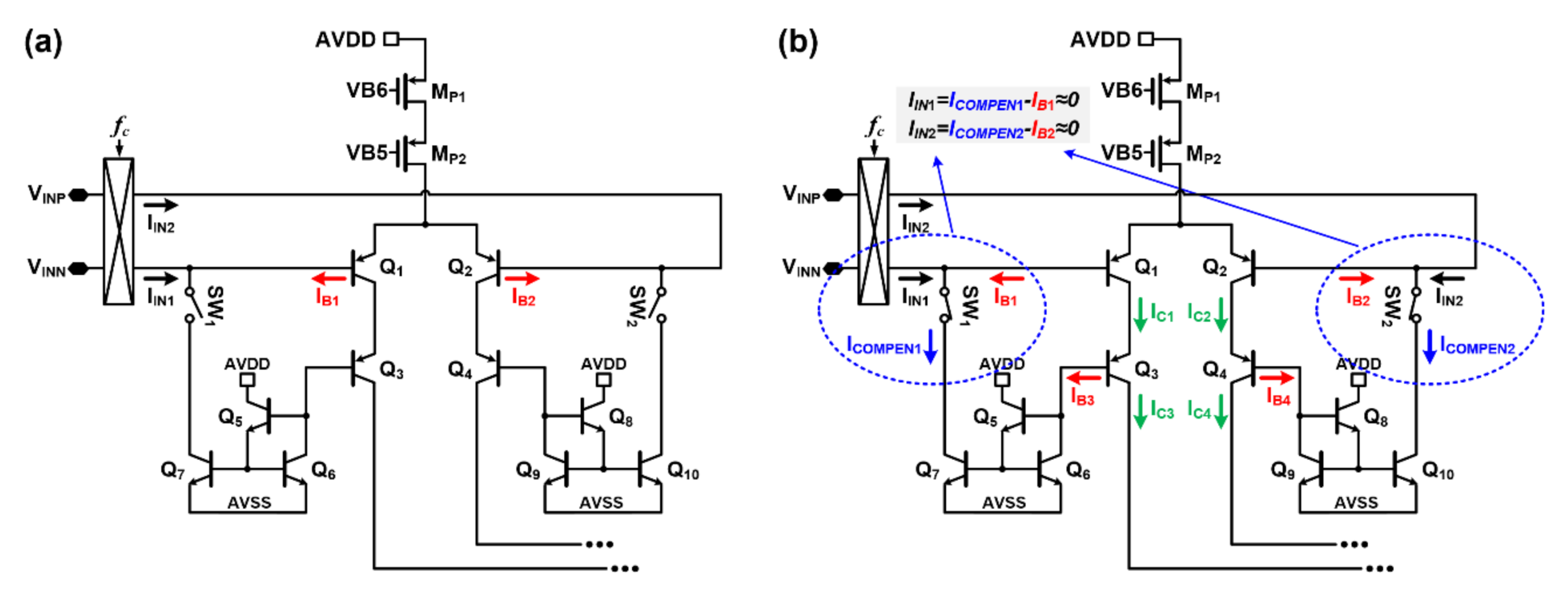
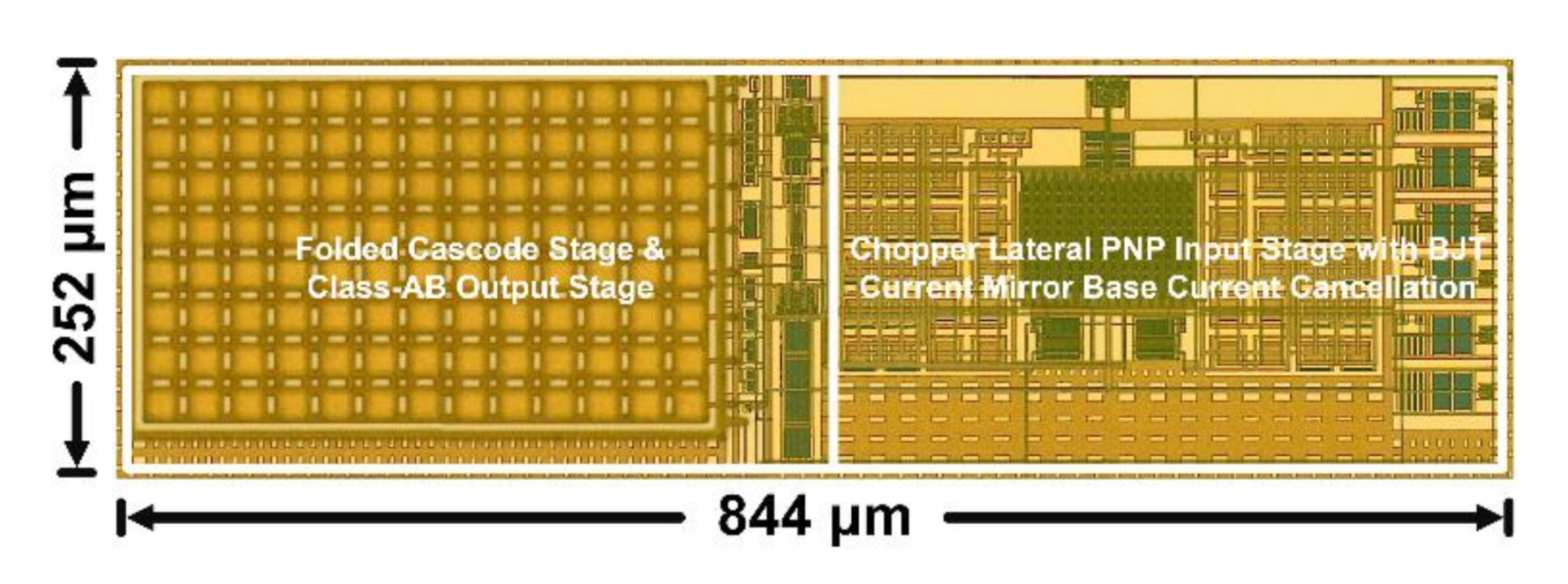
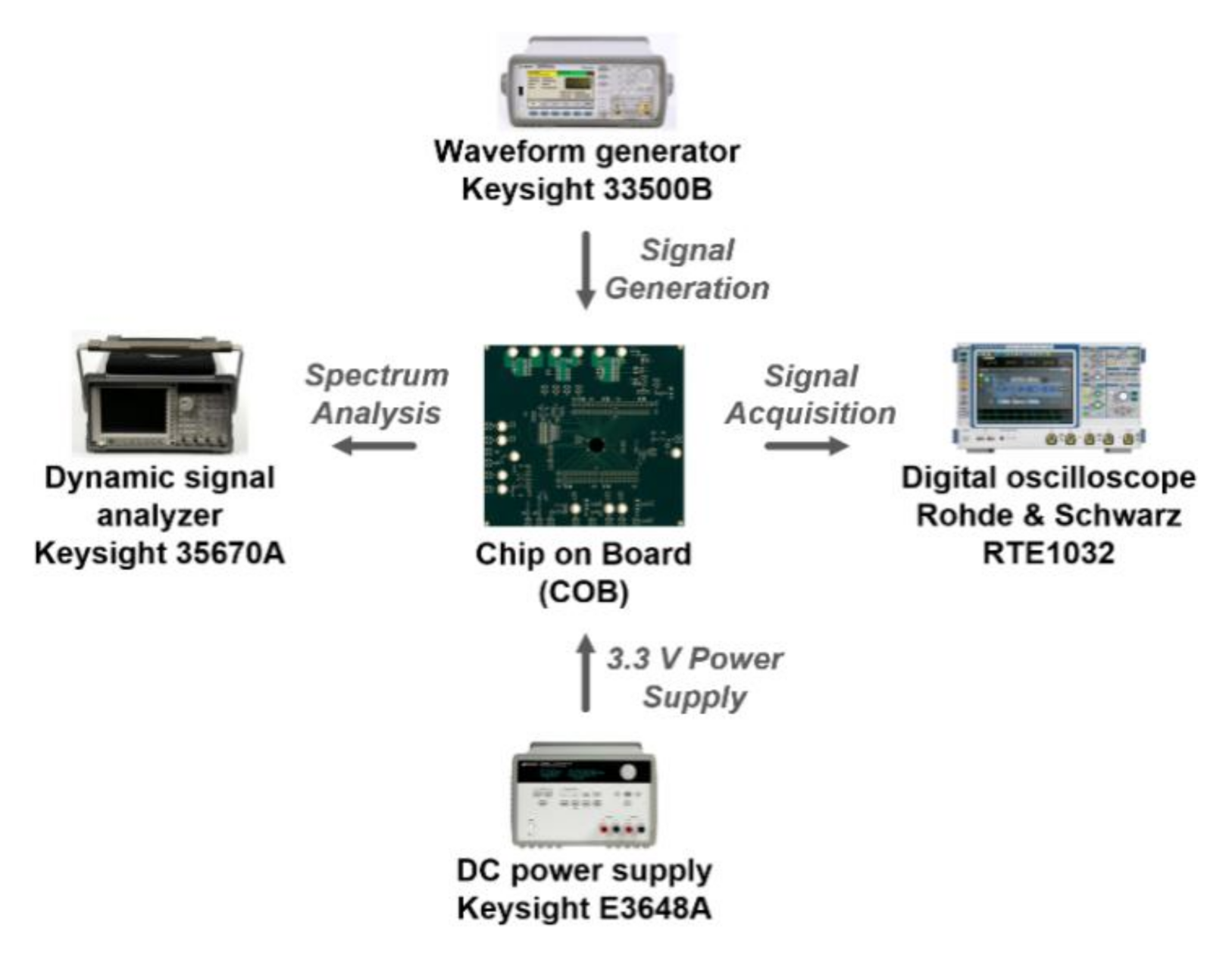
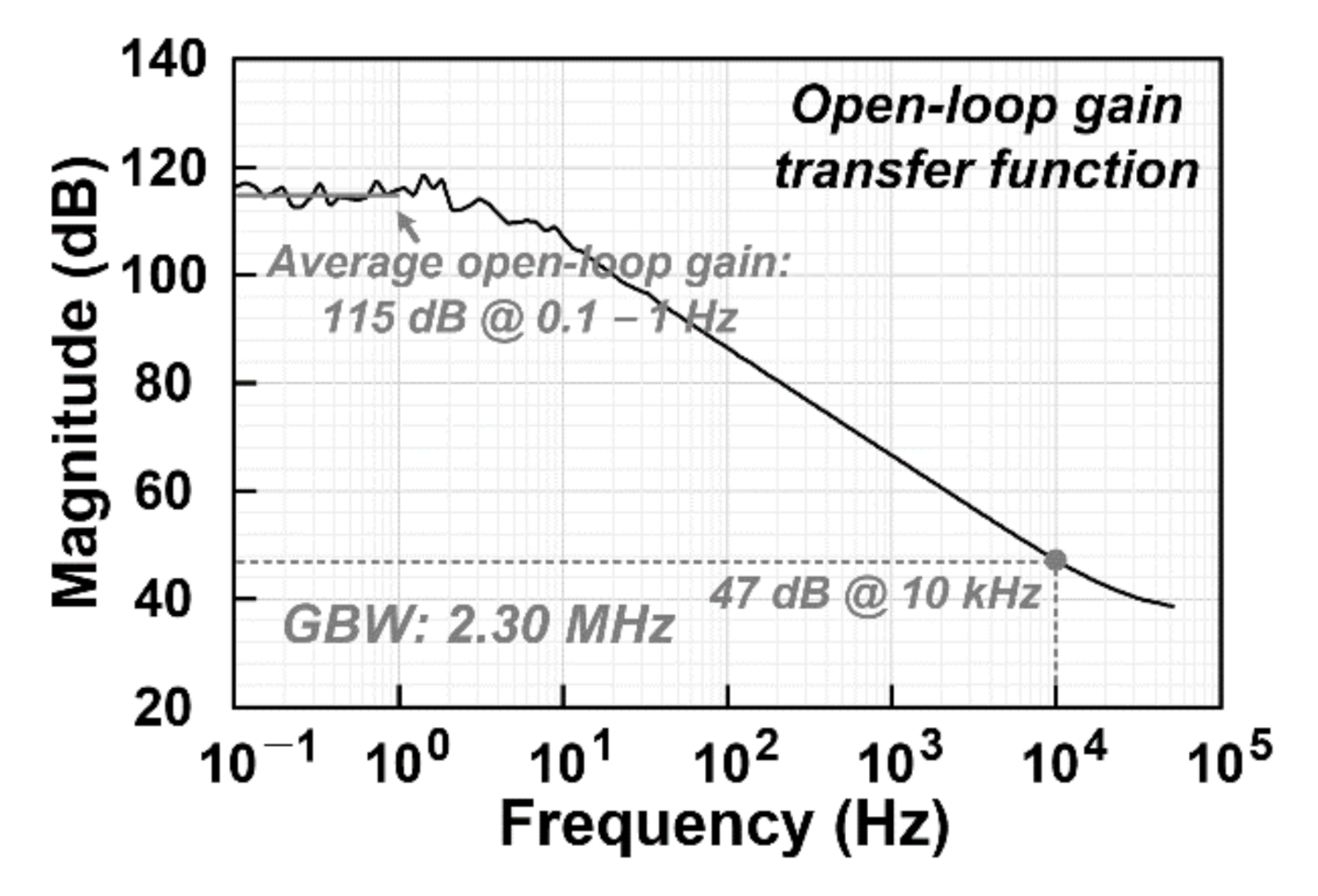
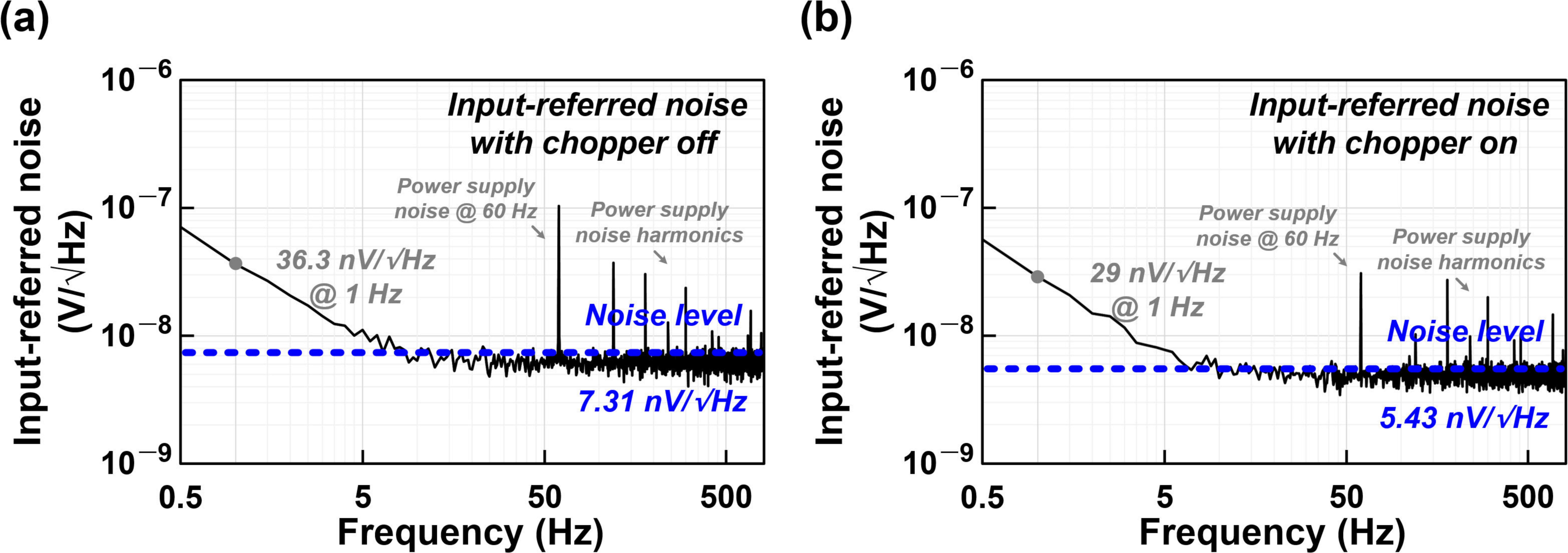
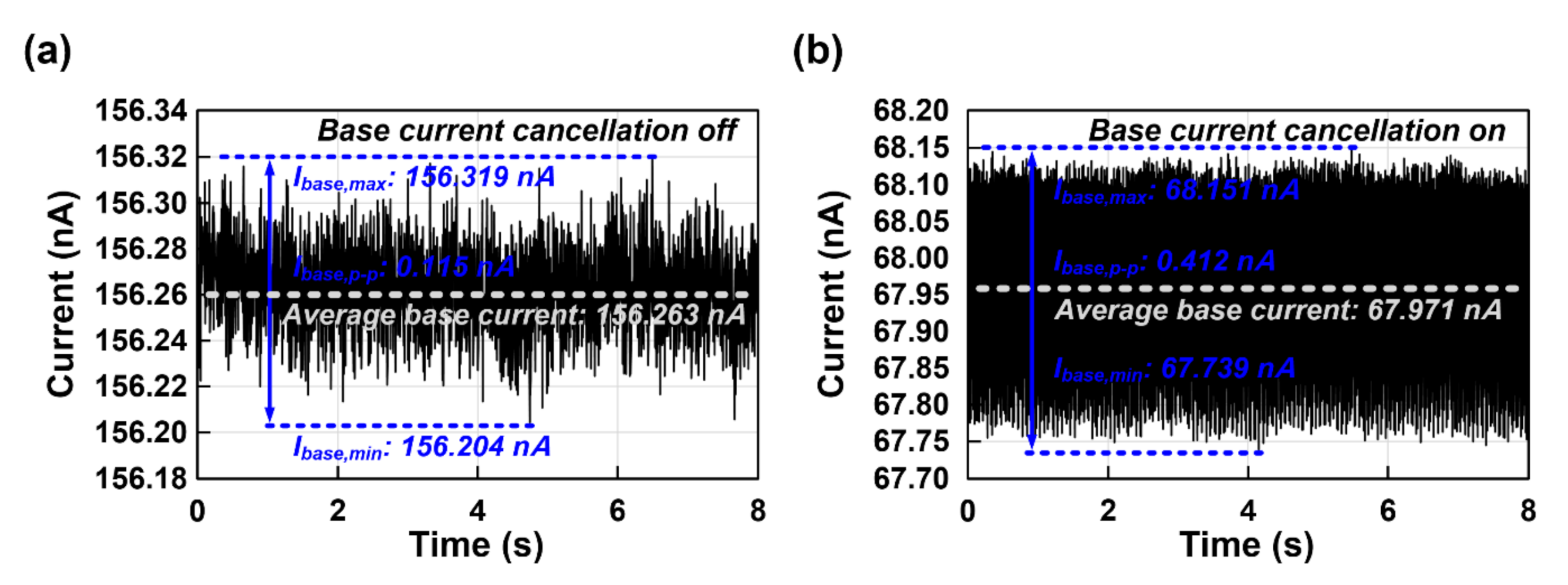
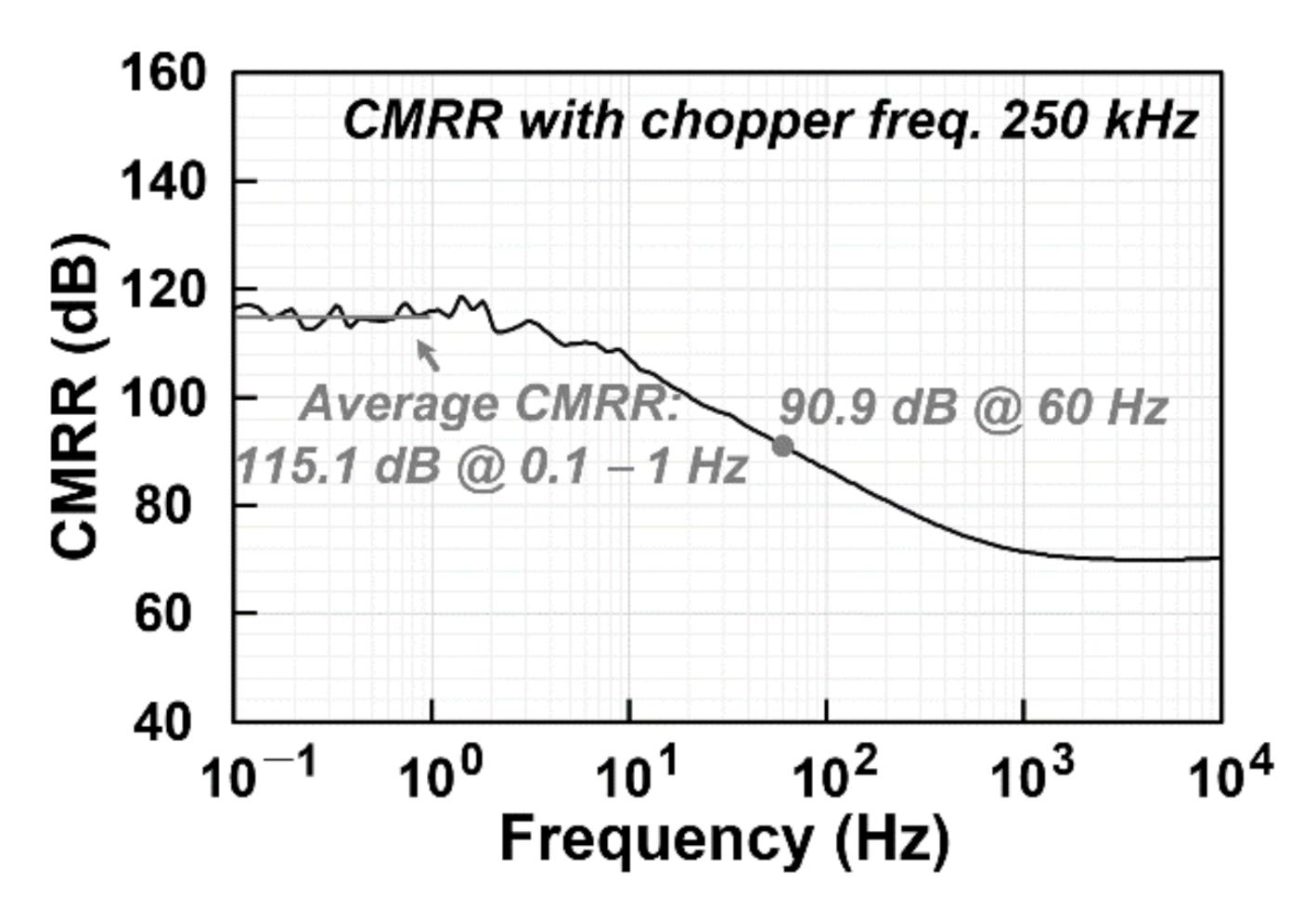
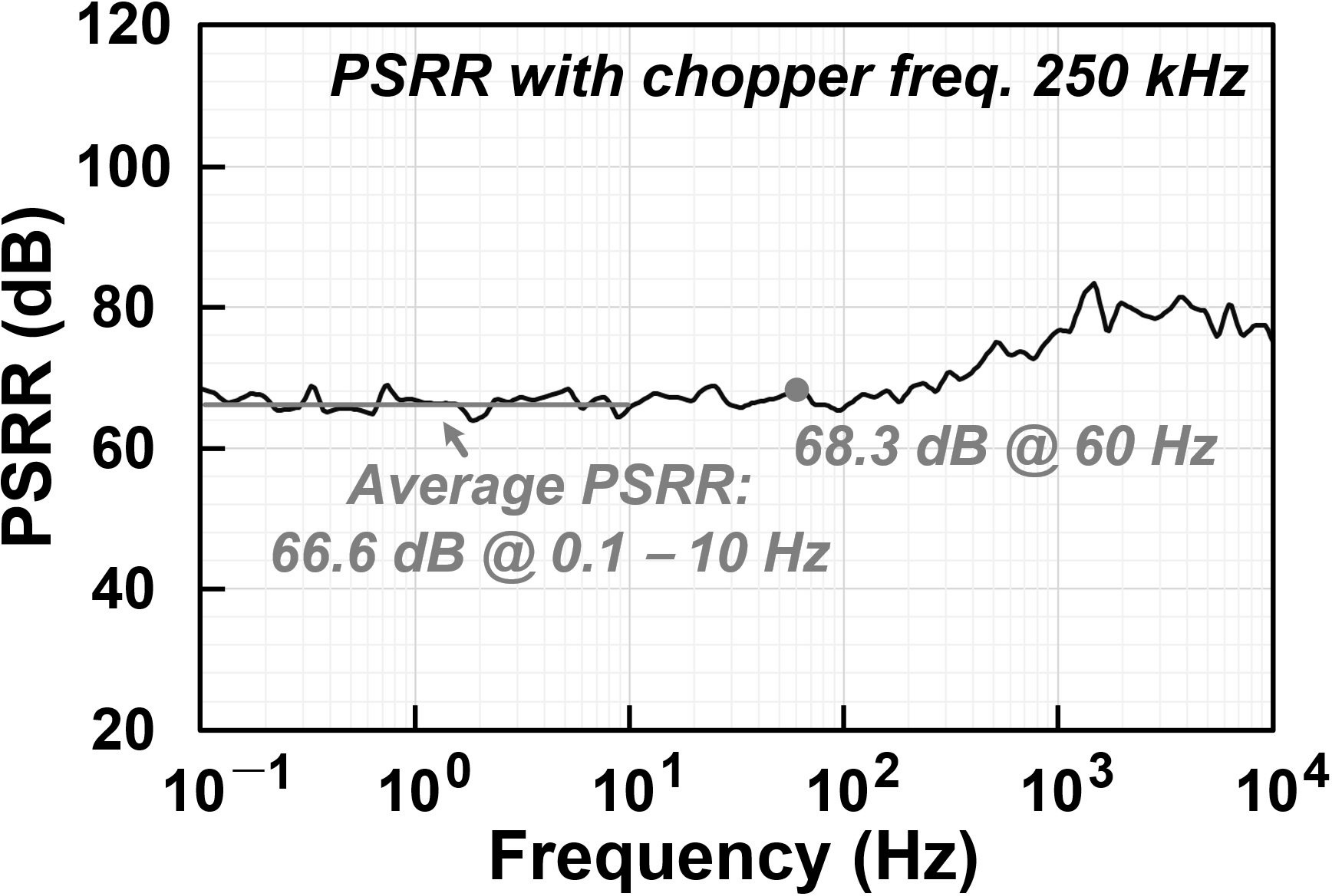
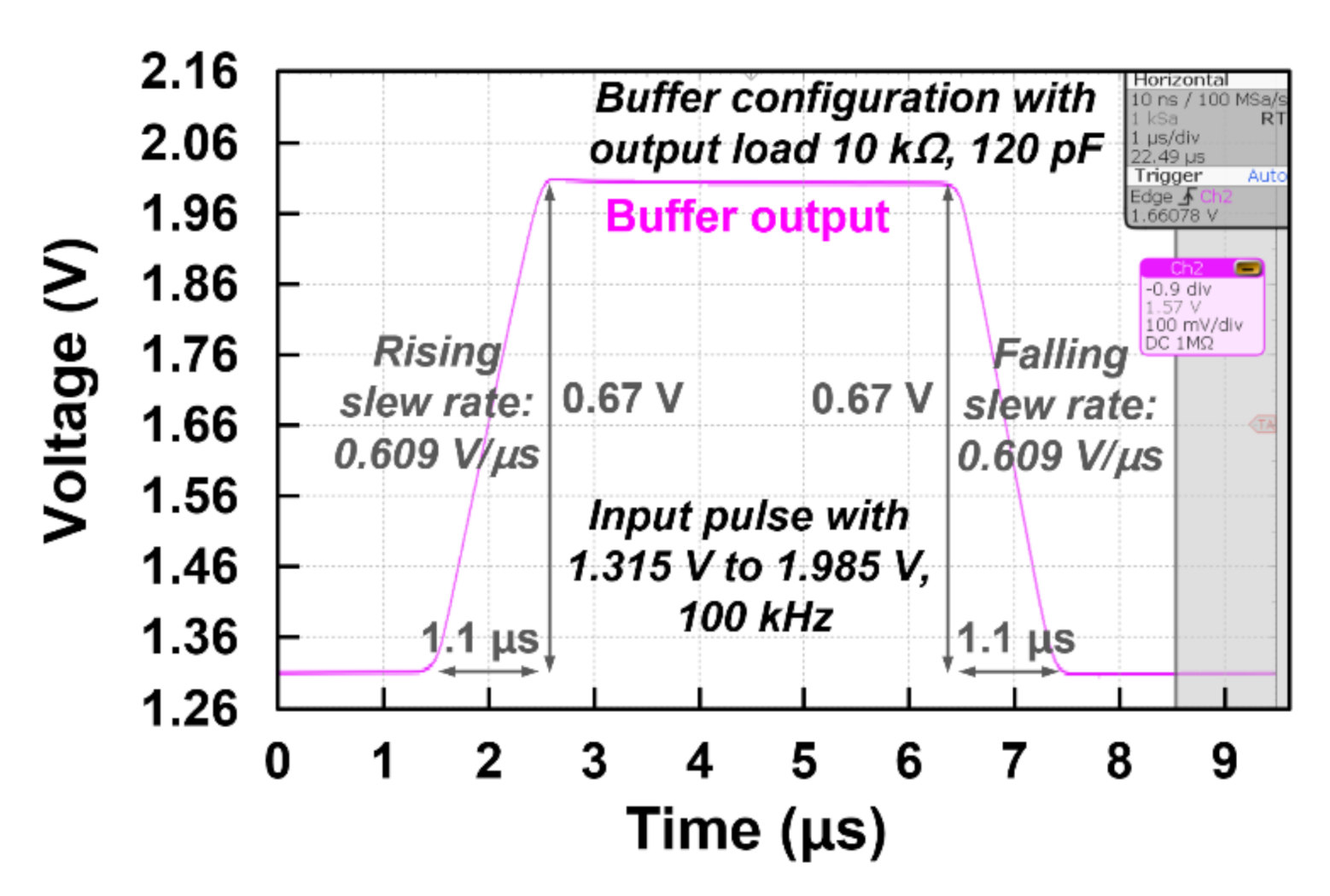


| This Work | [14] | [22] | [13] | [20] | |
|---|---|---|---|---|---|
| Year | 2020 | 2020 | 2011 | 2010 | 1995 |
| Process (µm) | 0.18 | 0.18 | 0.35 | 0.7 | 1.2 |
| Input stage transistor | BJT | MOS transistor | MOS transistor | MOS transistor | BJT |
| Amplifier scheme | Chopper amplifier | Multipath amplifier | Multipath amplifier | Multipath amplifier | 2-stage amplifier |
| Supply voltage (V) | 3.3 | 1.8 | 2.5–5.5 | 5 | ±2.5 |
| Current consumption (µA) | 278.3 | 96.7 | 1470 | 143 | 2100 |
| DC gain (dB) | 115 | >137 | >150 | - | 20.8 (closed loop) |
| BW (MHz) | 2.30 | 3.16 | 4 | 1.8 | 122 |
| Input referred noise (nV/√Hz) | 5.43 | 11.8 | 5.9 | 10.5 | 3.2 |
| Input bias current (nA) | 67.971 | - | 0.072 | <0.250 | 1680 |
| CMRR (dB) | 90.9 | >125 | >150 | 137 | 99.6 |
| PSRR (dB) | 68.3 | >100 | >150 | 120 | 67.6 |
| Area (mm2) | 0.213 | 1.18 | 1.26 | 1.8 | 0.211 |
| NEF | 3.98 * | 4.46 | 8.4 | 4.8 | 5.64 |
Publisher’s Note: MDPI stays neutral with regard to jurisdictional claims in published maps and institutional affiliations. |
© 2020 by the authors. Licensee MDPI, Basel, Switzerland. This article is an open access article distributed under the terms and conditions of the Creative Commons Attribution (CC BY) license (http://creativecommons.org/licenses/by/4.0/).
Share and Cite
Kim, H.; Kwon, Y.; You, D.; Choi, H.-W.; Kim, S.H.; Heo, H.; Kim, C.-Y.; Lee, H.-D.; Ko, H. A 5.43 nV/√Hz Chopper Operational Amplifier Using Lateral PNP Input Stage with BJT Current Mirror Base Current Cancellation. Appl. Sci. 2020, 10, 8376. https://doi.org/10.3390/app10238376
Kim H, Kwon Y, You D, Choi H-W, Kim SH, Heo H, Kim C-Y, Lee H-D, Ko H. A 5.43 nV/√Hz Chopper Operational Amplifier Using Lateral PNP Input Stage with BJT Current Mirror Base Current Cancellation. Applied Sciences. 2020; 10(23):8376. https://doi.org/10.3390/app10238376
Chicago/Turabian StyleKim, Hyungseup, Yongsu Kwon, Donggeun You, Hyun-Woong Choi, Seong Hyun Kim, Hyunwoo Heo, Choul-Young Kim, Hi-Deok Lee, and Hyoungho Ko. 2020. "A 5.43 nV/√Hz Chopper Operational Amplifier Using Lateral PNP Input Stage with BJT Current Mirror Base Current Cancellation" Applied Sciences 10, no. 23: 8376. https://doi.org/10.3390/app10238376
APA StyleKim, H., Kwon, Y., You, D., Choi, H.-W., Kim, S. H., Heo, H., Kim, C.-Y., Lee, H.-D., & Ko, H. (2020). A 5.43 nV/√Hz Chopper Operational Amplifier Using Lateral PNP Input Stage with BJT Current Mirror Base Current Cancellation. Applied Sciences, 10(23), 8376. https://doi.org/10.3390/app10238376






